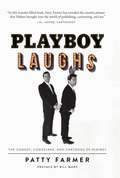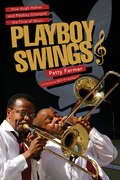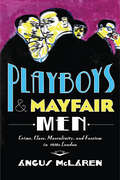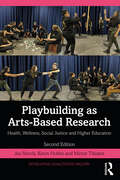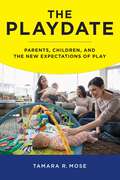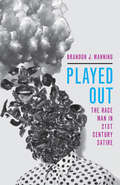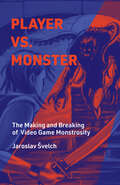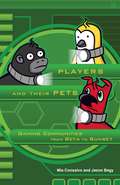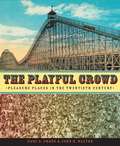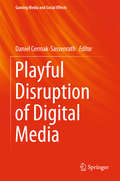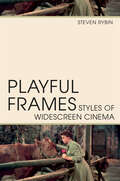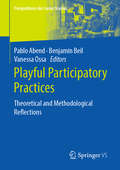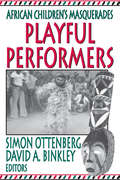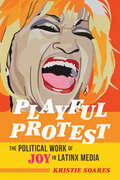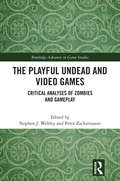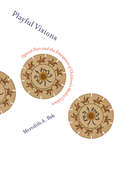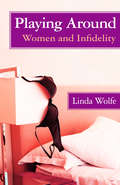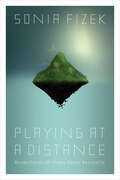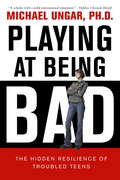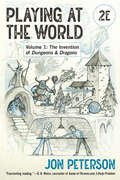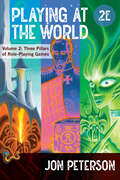- Table View
- List View
Playboy Laughs: The Comedy, Comedians, And Cartoons Of Playboy
by Patty FarmerFollowing her success with Playboy Swings, Patty Farmer looks at Playboy’s relationship with comedians and cartoonists in her new book Playboy Laughs. Playboy Laughs invites readers onto the sets of the organization’s groundbreaking TV shows, Playboy Penthouse and Playboy After Dark. These popular variety series brought top-tier comedians, impressionists, and monologists—as well as the finest musicians—into people’s homes each week. Readers will learn how before he ever dreamed of conquering the magazine publishing world—and along the way establish a worldwide brand—Hugh Hefner harbored aspirations of making his mark in the world as a cartoonist. Playboy Laughs delves into the darker aspects of the time as well, tackling the ways Playboy and its comedy stars helped break down social and racial barriers as well as sexual ones. Known for her devotion to meticulous research and clear, honest storytelling, Farmer has gained the full cooperation of the Playboy organization—and Hugh Hefner himself—making this not only an entertaining read but a trustworthy history of an under-appreciated aspect of American comic culture.
Playboy Swings: How Hugh Hefner and Playboy Changed the Face of Music
by Patty Farmer Will FriedwaldPlayboy—the magazine, the empire, the lifestyle—is one of the world’s best-known brands. Since the launch of Playboy magazine in 1953, two elements have been remarkably consistent: the first, obviously, is the celebration of nubile, female flesh. The second, readers may be surprised to learn, is Playboy’s involvement in the music scene. The Playboy experience was never just about sex but about lifestyle. Music—particularly the finest jazz, a personal passion of Hefner’s—has always been an essential component of that lifestyle. Playboy Swings focuses specifically on Playboy’s involvement in the music scene, its impact on popular entertainment (and vice versa), and the fabulous cadre of performers who took to the stages of the mythic Playboy Clubs and Jazz Festivals. Throughout Playboy Swings, Farmer demonstrates how Playboy helped change the world through music by integrating the TV shows, festivals, and the clubs.Complied through interviews with hundreds of people who were on the scene throughout Playboy’s rise, fall, and on-going renaissance, Playboy Swings carries readers on a seductive journey through the history of the empire—all the while focusing on the musical entertainment that made it unique. Hef’s personal passion for music—and his belief in it as a cornerstone of the Playboy ethos—has expressed itself in a wide range of media over Playboy’s 60-year history, and all of it comes alive in these pages. Famer takes the reader from the inception of the Playboy empire through the 1959 jazz festival, to the opening of club after club.With approximately 60 black and white photos, and a complete Playboy music reference guide, readers will think of music, not just Bunnies, when thinking about Playboy.Throughout the book, it is the artists who do most of the talking—and they have a lot to say about the golden era of Playboy entertainment.
Playboys and Mayfair Men: Crime, Class, Masculinity, and Fascism in 1930s London
by Angus McLarenThe shocking true story of a diamond theft gone wrong.In December 1937, four respectable young men in their twenties, all products of elite English public schools, conspired to lure to the luxurious Hyde Park Hotel a representative of Cartier, the renowned jewelry firm. There, the "Mayfair men" brutally bludgeoned diamond salesman Etienne Bellenger and made off with eight rings that today would be worth approximately half a million pounds. Such well-connected young people were not supposed to appear in the prisoner’s dock at the Old Bailey. Not surprisingly, the popular newspapers had a field day responding to the public’s insatiable appetite for news about the upper-crust rowdies and their unsavory pasts.In Playboys and Mayfair Men, Angus McLaren recounts the violent robbery and sensational trial that followed. He uses the case as a hook to draw the reader into a revelatory exploration of key interwar social issues, from masculinity and cultural decadence to broader anxieties about moral decay. In his gripping depiction of Mayfair’s celebrity high life, McLaren describes the crime in detail, as well as the police investigation, the suspects, their trial, and the aftermath of their convictions.
Playbuilding as Arts-Based Research: Health, Wellness, Social Justice and Higher Education (ISSN)
by Joe Norris Kevin Hobbs Mirror TheatreThe new edition of Playbuilding as Arts-Based Research details how playbuilding (creating an original performative work with a group) as a methodology has developed in qualitative research over the last 15 years.The second edition substantially updates the award-winning first edition by making connections to current research theories, providing complete scripts with URL links to videos, and including a new section with interviews with colleagues. Chapter 1 provides an in-depth discussion of the epistemological, ontological, axiological, aesthetic, and pedagogic stances that playbuilding takes, applying them to research in general. The value of a playful, trusting atmosphere; choices of style, casting, set, and location in representing the data; and pedagogical theories that guide participatory theatre are highlighted. Chapter 2 discusses how Mirror Theatre generates data, structures dramatic scenes, and conducts live and virtual participatory workshops. Chapter 3 is a thematized account of interviews with 23 colleagues who employ variations of playbuilding that show how playbuilding can be applied in a wide range of contemporary contexts and disciplines. Chapters 4 through 9 describe six projects that address topics of drinking choices and mental health issues on campus, person-centred care, homelessness, the transition to university, and co-op placements. They include both a theme and a style analyses and workshop ideas. Chapter 10, new to this edition, concludes with quantitative and qualitative data from audiences attesting to the efficacy of this approach.This is a fascinating resource for qualitative researchers, applied theatre practitioners, drama teachers, and those interested in social justice, who will appreciate how the book adeptly blends theory and practice, providing exemplars for their own projects.
The Playdate: Parents, Children, and the New Expectations of Play
by Tamara R. MoseA playdate is an organized meeting where parents come together with their children at a public or private location to interact socially or “play.” Children no longer simply “go out and play,” rather, play is arranged, scheduled, and parentally-approved and supervised. How do these playdates happen? Who gets asked and who doesn’t? What is acceptable play behavior? In The Playdate, Tamara R. Mose focuses on the parents of young children in New York City to explore how the shift from spontaneous and child-directed play to managed and adult-arranged playdates reveals the structures of modern parenting and the new realities of childhood. Mose argues that with the rise of moral panics surrounding child abuse, pedophilia, and fears about safety in the city, as well as helicopter parenting, and over-scheduling, the playdate has emerged as not just a necessity in terms of security and scheduling, but as the very hallmark of good parenting.Based on interviews with parents, teachers, childcare directors, and nannies from Brooklyn, Manhattan, Queens, and Long Island, the book provides a first-hand account of the strategies used by middle-class parents of young children to navigate social relationships—their own and those of their children. Mose shows how parents use playdates to improve their own experiences of raising children in New York City while at the same time carefully managing and ensuring their own social and cultural capital. Mose illustrates how the organization of playdates influences parents’ work lives, friendships, and public childrearing performances, and demonstrates how this may potentially influence the social development of both children and parents. Ultimately, this captivating and well-researched book shows that the playdate is much more than just “child’s play.”Tamara Mose on The Brian Lehrer Show
Played Out: The Race Man in Twenty-First-Century Satire
by Brandon J. ManningDating back to the blackface minstrel performances of Bert Williams and the trickster figure of Uncle Julius in Charles Chesnutt’s Conjure Tales, black humorists have negotiated American racial ideologies as they reclaimed the ability to represent themselves in the changing landscape of the early 20th century. Marginalized communities routinely use humor, specifically satire, to subvert the political, social, and cultural realities of race and racism in America. Through contemporary examples in popular culture and politics, including the work of Kendrick Lamar, Key and Peele and the presidency of Barack Obama and many others, in Played Out: The Race Man in 21st Century Satire author Brandon J. Manning examines how Black satirists create vulnerability to highlight the inner emotional lives of Black men. In focusing on vulnerability these satirists attend to America’s most basic assumptions about Black men. Contemporary Black satire is a highly visible and celebrated site of black masculine self-expression. Black satirists leverage this visibility to trouble discourses on race and gender in the Post-Civil Rights era. More specifically, contemporary Black satire uses laughter to decenter Black men from the socio-political tradition of the Race Man.
Player vs. Monster: The Making and Breaking of Video Game Monstrosity (Playful Thinking)
by Jaroslav SvelchA study of the gruesome game characters we love to beat—and what they tell us about ourselves.Since the early days of video games, monsters have played pivotal roles as dangers to be avoided, level bosses to be defeated, or targets to be destroyed for extra points. But why is the figure of the monster so important in gaming, and how have video games come to shape our culture&’s conceptions of monstrosity? To answer these questions, Player vs. Monster explores the past half-century of monsters in games, from the dragons of early tabletop role-playing games and the pixelated aliens of Space Invaders to the malformed mutants of The Last of Us and the bizarre beasts of Bloodborne, and reveals the common threads among them.Covering examples from aliens to zombies, Jaroslav Švelch explores the art of monster design and traces its influences from mythology, visual arts, popular culture, and tabletop role-playing games. At the same time, he shows that video games follow the Cold War–era notion of clearly defined, calculable enemies, portraying monsters as figures that are irredeemably evil yet invariably vulnerable to defeat. He explains the appeal of such simplistic video game monsters, but also explores how the medium could evolve to present more nuanced depictions of monstrosity.
Players and Their Pets: Gaming Communities from Beta to Sunset
by Mia Consalvo Jason BegyIn the world of massively multiplayer online games (MMOGs), Faunasphere was but a blip on the screen in its short public life from 2009 to 2011. Its devoted players, many of them middle-aged women, entered a world that did not build on common fantasy or science-fiction tropes. There was no evil to defeat or realms to conquer, only friendly animals to care for and pollution to fight.In Players and Their Pets, Mia Consalvo and Jason Begy argue that its very difference makes it critically important—even more so than the large, commercially successful games such as World of Warcraft that have all too often shaped game studies discourse. Consalvo and Begy demonstrate how the beta period of an MMOG can establish social norms that guide how the game is played. They also show how a game&’s platform creates expectations for how the game will work and who is playing it—and what happens when those expectations clash with the reality. Even while telling the story of this particular game and its predominantly female players, however, Players and Their Pets cautions against oversimplifying players based on their gender. Faunasphere&’s playerbase enjoyed diverse aspects of the game, for varied reasons. No other game studies book tracks the entire life cycle of an online game to examine how the game evolved in terms of design as well as how its player community responded to changes and events. The brief life of Faunasphere makes this possible.
The Playful Crowd: Pleasure Places in the Twentieth Century
by Gary Cross John WaltonDuring the first part of the twentieth century thousands of working-class New Yorkers flocked to Coney Island in search of a release from their workaday lives and the values of bourgeois society. On the other side of the Atlantic, British workers headed off to the beach resort of Blackpool for entertainment and relaxation. However, by the middle of the century, a new type of park began to emerge, providing well-ordered, squeaky-clean, and carefully orchestrated corporate entertainment. Contrasting the experiences of Coney Island and Blackpool with those of Disneyland and Beamish, Gary S. Cross and John K. Walton explore playful crowds and the pursuit of pleasure in the twentieth century to offer a transatlantic perspective on changing ideas about leisure, class, and mass culture. Blackpool and Coney Island were the definitive playgrounds of the industrial working class. Teeming crowds partook of a gritty vulgarity that offered a variety of pleasures and thrills from roller coaster rides and freak shows to dance halls and dioramas of exotic locales. Responding to the new money and mobility of the working class, the purveyors of Coney Island and Blackpool offered the playful crowd an "industrial saturnalia."Cross and Walton capture the sights and sounds of Blackpool and Coney Island and consider how these "Sodoms by the sea" flouted the social and cultural status quo. The authors also examine the resorts' very different fates as Coney Island has now become a mere shadow of its former self while Blackpool continues to lure visitors and offer new attractions. The authors also explore the experiences offered at Disneyland and Beamish, a heritage park that celebrates Britain's industrial and social history. While both parks borrowed elements from their predecessors, they also adapted to the longings and concerns of postwar consumer culture. Appealing to middle-class families, Disney provided crowds a chance to indulge in child-like innocence and a nostalgia for a simpler time. At Beamish, crowds gathered to find an escape from the fragmented and hedonistic life of modern society in a reconstructed realm of the past where local traditions and nature prevail.
Playful Disruption of Digital Media (Gaming Media and Social Effects Ser.)
by Daniel Cermak-SassenrathThis book starts with the proposition that digital media invite play and indeed need to be played by their everyday users. Play is probably one of the most visible and powerful ways to appropriate the digital world. The diverse, emerging practices of digital media appear to be essentially playful: Users are involved and active, produce form and content, spread, exchange and consume it, take risks, are conscious of their own goals and the possibilities of achieving them, are skilled and know how to acquire more skills. They share a perspective of can-do, a curiosity of what happens next? Play can be observed in social, economic, political, artistic, educational and criminal contexts and endeavours. It is employed as a (counter) strategy, for tacit or open resistance, as a method and productive practice, and something people do for fun.The book aims to define a particular contemporary attitude, a playful approach to media. It identifies some common ground and key principles in this novel terrain. Instead of looking at play and how it branches into different disciplines like business and education, the phenomenon of play in digital media is approached unconstrained by disciplinary boundaries. The contributions in this book provide a glimpse of a playful technological revolution that is a joyful celebration of possibilities that new media afford. This book is not a practical guide on how to hack a system or to pirate music, but provides critical insights into the unintended, artistic, fun, subversive, and sometimes dodgy applications of digital media.Contributions from Chris Crawford, Mathias Fuchs, Rilla Khaled, Sybille Lammes, Eva and Franco Mattes, Florian 'Floyd' Mueller, Michael Nitsche, Julian Oliver, and others cover and address topics such as reflective game design, identity and people's engagement in online media, conflicts and challenging opportunities for play, playing with cartographical interfaces, player-emergent production practices, the re-purposing of data, game creation as an educational approach, the ludification of society, the creation of meaning within and without play, the internalisation and subversion of roles through play, and the boundaries of play.
Playful Frames: Styles of Widescreen Cinema (Techniques of the Moving Image)
by Steven RybinA widescreen frame in cinema beckons the eye to playfully, creatively roam. Such technology also gives inventive filmmakers room to disrupt and redirect audience expectations, surprising viewers through the use of a wider, more expansive screen. Playful Frames: Styles of Widescreen Cinema studies the poetics of the auteur-driven widescreen image, offering nimble, expansive analyses of the work of four distinctive filmmakers – Jean Negulesco, Blake Edwards, Robert Altman, and John Carpenter – who creatively inhabited the nooks and crannies of widescreen moviemaking during the final decades of the twentieth century. Exploring the relationship between aspect ratio and subject matter, Playful Frames shows how directors make puckish use of widescreen technology. All four of these distinctive filmmakers reimagined popular genres (such as melodrama, slapstick comedy, film noir, science fiction, and horror cinema) through their use of the wide frame, and each brings a range of intermedial interests (painting, performance, and music) to their use of the widescreen image. This study looks specifically at the technological underpinnings, aesthetic shapes, and interpretive implications of these four directors’ creative use of widescreen, offering a way to reconsider the way wide imagery still has the potential to amaze and move us today.
Playful Participatory Practices: Theoretical and Methodological Reflections (Perspektiven der Game Studies)
by Pablo Abend Benjamin Beil Vanessa OssaThe volume addresses the matter of participatory media practices as playful appropriations within current digital media culture and artistic research. The aim is to explore and trace the shifting boundaries between media production and media use, and to develop concepts and methodologies that work within participatory media cultures. Therefore the articles explore and establish nuanced approaches to the oftentimes playful practices associated with the appropriation of technology.
Playful Performers: African Children's Masquerades
by David BinkleyAfrican children develop aesthetic sensibilities at an early age, roughly from four to fourteen years. By the time they become full-fledged adolescents they may have had up to ten years experience with various art forms--masking, music, costuming, dancing, and performance. Aesthetic learning is vital to their maturation. The contributors to this volume argue that the idea that learning the aesthetics of a culture only occurs after maturity is false, as is the idea that children wearing masks is only play, and is not to be taken seriously.Playful Performers is a study of children's masquerades in Africa. The contributors describe specific cases of young children's masking in the areas of west, central, and southern Africa, which also happen to be the major areas of adult masquerading. The volume reveals the considerable creativity and ingenuity that children exhibit in preparing costumes, masks and musical instruments, and in playing music, dancing, singing, and acting. The book includes over 50 pages of black and white photographs, which illustrate and elaborate upon the authors' main points. The editors describe general categories of children's masquerades. In each of the three masking categories children's relationships to their parents and other adults differ, from a close relationship to some independence to almost complete independence. No other major work has covered this aspect of African children at this age level. The book offers a challenging perspective on young children, seeing them as active agents in their own culture rather than passive recipients of culture as taught by parents and other elders. It will be interesting reading for anthropologists, art historians, educators, and African studies specialists alike.
A Playful Production Process: For Game Designers (and Everyone)
by Richard LemarchandHow to achieve a happier and healthier game design process by connecting the creative aspects of game design with techniques for effective project management. This book teaches game designers, aspiring game developers, and game design students how to take a digital game project from start to finish—from conceptualizing and designing to building, playtesting, and iterating—while avoiding the uncontrolled overwork known among developers as &“crunch.&” Written by a legendary game designer, A Playful Production Process outlines a process that connects the creative aspects of game design with proven techniques for effective project management. The book outlines four project phases—ideation, preproduction, full production, and post-production—that give designers and developers the milestones they need to advance from the first glimmerings of an idea to a finished game.
Playful Protest: The Political Work of Joy in Latinx Media (Feminist Media Studies)
by Kristie SoaresPleasure-based politics in Puerto Rican and Cuban pop culture Joy is a politicized form of pleasure that goes beyond gratification to challenge norms of gender, sexuality, race, and class. Kristie Soares focuses on the diasporic media of Puerto Rico and Cuba to examine how music, public activist demonstrations, social media, sitcoms, and other areas of culture resist the dominant stories told about Latinx joy. As she shows, Latinx creators compose versions of joy central to social and political struggle and at odds with colonialist and imperialist narratives that equate joy with political docility and a lack of intelligence. Soares builds her analysis around chapters that delve into gozando in salsa music, precise joy among the New Young Lords Party, choteo in the comedy ¿Qué Pasa U.S.A.?, azúcar in the life and death of Celia Cruz, dale as Pitbull’s signature affect, and Alexandria Ocasio-Cortez’s use of silliness to take seriously political violence. Daring and original, Playful Protest examines how Latinx creators resist the idea that joy only exists outside politics and activist struggle.
The Playful Undead and Video Games: Critical Analyses of Zombies and Gameplay (Routledge Advances in Game Studies)
by Peter Zackariasson Stephen J. WebleyThis book explores the central role of the zombie in contemporary popular culture as they appear in video games. Moving beyond traditional explanations of their enduring appeal – that they embody an aesthetic that combines horror with a mindless target; that lower age ratings for zombie games widen the market; or that Artificial Intelligence routines for zombies are easier to develop – the book provides a multidisciplinary and comprehensive look at this cultural phenomenon. Drawing on detailed case studies from across the genre, contributors from a variety of backgrounds offer insights into how the study of zombies in the context of video games informs an analysis of their impact on contemporary popular culture. Issues such as gender, politics, intellectual property law, queer theory, narrative storytelling and worldbuilding, videogame techniques and technology, and man’s relation to monsters are closely examined in their relation to zombie video games. Breaking new ground in the study of video games and popular culture, this volume will be of interest to researchers in a broad range of areas including media, popular culture, video games, and media psychology.
Playful Visions: Optical Toys and the Emergence of Children's Media Culture (The\mit Press Ser.)
by Meredith A. BakThe kaleidoscope, the stereoscope, and other nineteenth-century optical toys analyzed as “new media” of their era, provoking anxieties similar to our own about children and screens.In the nineteenth century, the kaleidoscope, the thaumatrope, the zoetrope, the stereoscope, and other optical toys were standard accessories of a middle-class childhood, used both at home and at school. In Playful Visions, Meredith Bak argues that the optical toys of the nineteenth century were the “new media” of their era, teaching children to be discerning consumers of media—and also provoking anxieties similar to contemporary worries about children's screen time. Bak shows that optical toys—which produced visual effects ranging from a moving image to the illusion of depth—established and reinforced a new understanding of vision as an interpretive process. At the same time, the expansion of the middle class as well as education and labor reforms contributed to a new notion of childhood as a time of innocence and play. Modern media culture and the emergence of modern Western childhood are thus deeply interconnected.Drawing on extensive archival research, Bak discusses, among other things, the circulation of optical toys, and the wide visibility gained by their appearance as printed templates and textual descriptions in periodicals; expanding conceptions of literacy, which came to include visual acuity; and how optical play allowed children to exercise a sense of visual mastery. She examines optical toys alongside related visual technologies including chromolithography—which inspired both chromatic delight and chromophobia. Finally, considering the contemporary use of optical toys in advertising, education, and art, Bak analyzes the endurance of nineteenth-century visual paradigms.
Playground: A Childhood Lost Inside the Playboy Mansion
by Jennifer SaginorYou are six years old. Every day after school your father takes you to a sprawling castle filled with exotic animals, bowls of candy, and half-naked women catering to your every need. You have your own room. You have new friends. You have an uncle Hef who's always there for you. Welcome to the world of Playground, the true story of a young girl who grew up inside the Playboy Mansion. By the time she was fourteen, she'd done countless drugs, had a secret affair with Hef's girlfriend, and was already losing her grip on reality. Schoolwork, family, and "ordinary people" had no meaning behind the iron gates of the Mansion, where celebrities frolicked, pool parties abounded, and her own father -- Hugh Hefner's personal physician and best friend, the man nicknamed "Dr. Feel Good" -- typically held court. Every day was a party, every night was an adventure, and through it all was a young girl falling faster and faster down the rabbit hole -- trying desperately hard not to get lost.
Playhouses and Privilege: The Architecture of Elite Childhood
by Abigail A. Van SlyckExamining playhouses of the super-rich to understand how architecture contributed to the construction of elite identity and modern childhoodPlayhouses and Privilege explores children&’s playhouses built on British and American estates between the 1850s and the mid-1930s. Different from the prefabricated buildings that later populated suburban backyards, these playhouses were often fully functional cottages designed by well-known architects for British royalty, American industrialists, and Hollywood stars. As Abigail A. Van Slyck shows, these buildings were more than extravagant spaces to cultivate children&’s imaginations and fantasy lives. Reviewing a rich archive that includes extant buildings, site plans, family photographs, baby books, and intimate household correspondence, Van Slyck demonstrates that these structures were tools of social reproduction shaped by elite parents&’ attitudes toward child-rearing, education, and class privilege. Recognizing playhouses as stages for the purposeful performance of upper-class identity, she illuminates their importance in influencing children to internalize gendered codes of conduct as they enacted rituals of hospitality and learned how to supervise servants. From Queen Victoria and Prince Albert&’s Swiss Cottage, built on their Osborne estate in 1853, to the children&’s cottage constructed on the grounds of Cornelius Vanderbilt&’s Newport mansion in 1886, and from the miniature bungalow commissioned in 1926 for the Dodge Brothers Motor Company heiress to the corporate-sponsored glass-block playhouse given to Shirley Temple in 1936, Van Slyck surveys a variety of playhouses and their milieus to trace the evolution of elite childhood and the broader social practices of wealth. Playhouses and Privilege makes clear that, far from being frivolous, playhouses were carefully planned architectural manifestations of adult concerns, integral to the reproduction of class privilege.
Playing a New Game: A Black Woman's Guide to Being Well and Thriving in the Workplace
by Tammy Lewis Wilborn, PhDDrawing on first-hand clinical insight and scientific research, Dr. Wilborn offers much-needed advice on how women of color can be high-performing and successful professionally, without sacrificing their physical, mental, and emotional wellness. Black and brown women have been making profound strides in leadership and professional achievement, despite facing the added hurdles of both sexism and racism in the workplace. But so often, excelling at work comes at the expense of their wellness: the chronic stressors and demands on Black women can result in negative physical health outcomes such as sleep disturbance, hypertension, and diabetes, and negative mental health outcomes including anxiety and depression. We cannot talk about career advancement for Black and brown women without talking about strategies that promote their total wellbeing.Playing a New Game offers women a new way forward, in which ambition and wellness can not only coexist, but bolster each other. With insights from her 20 years of professional counseling experience and extensive research, mental health expert Dr. Tammy Wilborn expands the dialogue on BIPOC women&’s experiences of race and gender stereotypes at work, exploring them as a wellness issue. Through her evidence-based best practices that promote self-care and self-empowerment as necessary tools for professional success, Black and brown women can flip the script by prioritizing their wellness even as they advance professionally.
Playing Around: Women and Infidelity
by Linda WolfeIntimate, explosive, revelatory American women talk about having been unfaithful to their primary sexual partners. Why did they cheat? How and where did they manage to meet with their lovers? Were the affairs more sexually satisfying than the women's primary relationships? More emotionally satisfying? Did they feel guilt? Did they keep their affairs secret or admit them to partners or friends? And, whether confessed or not, how did infidelity affect the women's lives? Intimate and explosive, Playing Around explores the pleasures and pains of female infidelity and illuminates women's participation in a behavior that is often viewed as predominantly male.
Playing at a Distance: Borderlands of Video Game Aesthetic
by Sonia FizekAn essential exploration of video game aesthetic that decenters the human player and challenges what it means to play.Do we play video games or do video games play us? Is nonhuman play a mere paradox or the future of gaming? And what do video games have to do with quantum theory? In Playing at a Distance, Sonia Fizek engages with these and many more daunting questions, forging new ways to think and talk about games and play that decenter the human player and explore a variety of play formats and practices that require surprisingly little human action. Idling in clicker games, wandering in walking simulators, automating gameplay with bots, or simply watching games rather than playing them—Fizek shows how these seemingly marginal cases are central to understanding how we play in the digital age. Introducing the concept of distance, Fizek reorients our view of computer-mediated play. To &“play at a distance,&” she says, is to delegate the immediate action to the machine and to become participants in an algorithmic spectacle. Distance as a media aesthetic framework enables the reader to come to terms with the ambiguity and aesthetic diversity of play. Drawing on concepts from philosophy, media theory, and posthumanism, as well as cultural and film studies, Playing at a Distance invites a wider understanding of what digital games and gaming are in all their diverse experiences and forms. In challenging the common perception of video games as inherently interactive, the book contributes to our understanding of the computer&’s influence on practices of play—and prods us to think more broadly about what it means to play.
Playing at Being Bad: The Hidden Resilience of Troubled Teens
by Michael Ungar"Our most troubled youth are far more resilient and healthy than we are ready to admit. If we take the time to listen very closely to our children speak about their experiences beyond our front doors, we hear an entirely different story about their lives than the one we adults tell. Unlike many other books about difficult kids that reflect the wisdom of adults, this one explores the truth of adolescence. It builds on recent explorations of youth such as Mary Pipher's Reviving Ophelia, Judith Rich Harris' The Nurture Assumption, and William Pollack's Real Boys. It examines emerging trends in psychology, as well as recent innovations in work with our most unhealthy young people. Playing at Being Bad offers particular insight for parents, teachers, and caregivers of troubled youth just beginning, or already stuck in, patterns of delinquency, drug or alcohol addiction, sexual promiscuity, violence, suicide, depression, and truancy. This book tells the story of the teens Ungar worked with for more than fifteen years, taking a close look at the crises kids face, while exploring the important role that adults can play in keeping dangerous and delinquent youth from drifting further into trouble.
Playing at the World, 2E, Volume 1: The Invention of Dungeons & Dragons (Game Histories)
by Jon PetersonThe first volume of two in a new, updated edition of the 2012 book Playing at the World, which charts the vast and complex history of role-playing games.This new edition of Playing at the World is the first of two volumes that update the 720-page original tome of the same name from 2012. This first volume is The Invention of Dungeons & Dragons, which explores the publication of that iconic game. (The second volume is The Three Pillars of Role-Playing Games, a deeper dive into the history of the setting, system, and character of D & D.) In this first volume, Jon Peterson distills the story of how the wargaming clubs and fanzines circulating around the upper Midwest in the 1970s culminated in Gary Gygax and Dave Arneson’s seminal role-playing game, D & D. It augments the research of the original editions with new insights into the crucial period in 1972–3 when D & D began to take shape.Drawing from primary sources ranging from eighteenth-century strategists to modern hobbyists, Playing at the World explores the origins of wargames and roleplaying through the history of conflict simulations and the eccentric characters who drove the creation of a signature cultural innovation in the late twentieth century. Filled with unparalleled archival research (from obscure fanzines to letters, drafts, and other ephemera), this new edition of Playing at the World is the ultimate geek’s guide to the original RPG. As such, it is an indispensable resource for academics and game fans exploring the origins of the hobby.
Playing at the World, 2E, Volume 2: Three Pillars of Role-Playing Games (Game Histories)
by Jon PetersonThe second volume of two in a new, updated edition of the 2012 book Playing at the World, which charts the vast and complex history of role-playing games.This new edition of Playing at the World is the second of two volumes that update the 720-page original tome of the same name from 2012. This second volume is The Three Pillars of Role-Playing Games, a deep dive into the history of the setting, system, and characters of Dungeons & Dragons—the three pillars indicated by the volume&’s title. (The first volume of the new edition is The Invention of Dungeons & Dragons, which explores the publication and reception of that iconic game.)In this second volume, Jon Peterson covers the medieval fantasy setting—the first pillar—and addresses why the first role-playing game evolved around fantasy and medieval settings as opposed to some other historical setting. In the second pillar, the author explores how the rules of wargames, from their roots in chess variants from eighteenth-century Germany, developed into those of role-playing games. Finally, the third pillar focuses on character, perhaps the most elusive of the three pillars, and investigates how precedents governed the introduction of characters to games more so than the original D&D rule books.Filled with unparalleled archival research (from obscure fanzines to letters, drafts, and other ephemera), this new edition of Playing at the World is the ultimate geek&’s guide to the original RPG. As such, it is an indispensable resource for academics and game fans exploring the origins of the hobby.
